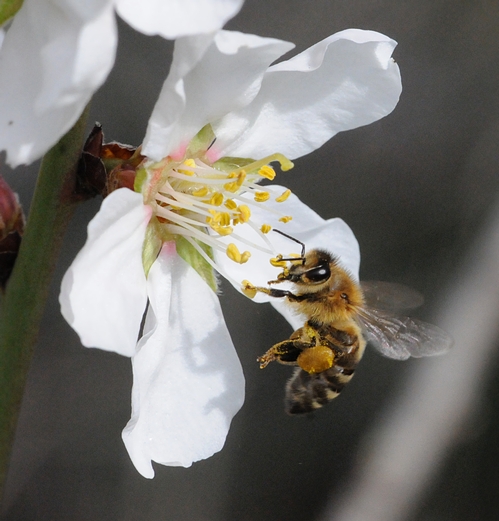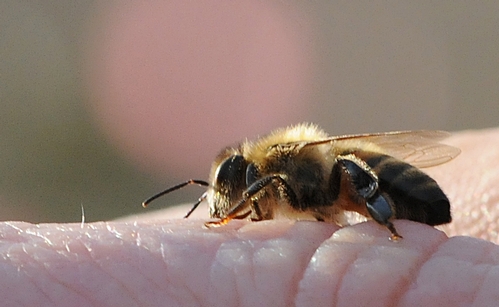Posts Tagged: Almonds
No Day Off
It's Presidents' Day today, a holiday for most of us but not for the honey bees.The bees are buzzing in and around the almond blossoms, collecting...

Honey Bee

Pollen Dust

Beach Ball

Wild Blue Yonder
Plant It and They Will Come
Plant it and they will come. The Häagen-Dazs Honey Bee Haven, planted last fall, is already attracting a few honey bees. The half-acre bee friendly...

Making Headway

Almond blossoms

Haven Visitor
When will Mother Nature get it right?
Farmers reeling from three years of drought and an unseasonably warm January are now worried about rainfall at the wrong time of year, according to a story in today's Redding Record Searchlight.
Almond trees that bloomed early because of warm January weather suffered some frost damage. Now, rain during spring bloom is inhibiting pollination. (Who can blame bees for curling up with a good book on rainy days?) Wet weather also raises concerns about fungal diseases. But despite these abnormal weather patterns, UC Cooperative Extension farm advisor Bill Krueger assured writer Debra Moore that almond farmers will still have nuts to harvest next fall.
"If there is good weather between storms, it will give the bees a chance to pollinate," Krueger was quoted. "The diseases won't be as bad as they would have been had these been warm storms."
The article also covered problems experienced by cattle ranchers when precipitation doesn't arrive on schedule.
UCCE livestock program representative Josh Davy told the reporter that February rain storms are filling up stock water ponds, but won't help farmers concerned about this season's rangeland vegetation, on which they rely for animal rations.
"The annual grasses are germinated with fall rains," Davy was quoted. "And this rain has come too late."
What Price Pollination?
What are insect pollinators worth to the global economy? Well, it's a lot less than the Wall Street bailout...er...rescue plan. Recent research...

The honey bee, resplendent here with silvery wings, is gold to the global economy. (Photo by Kathy Keatley Garvey)

A honey bee visits an almond blossom. California's 700,000 acres of almonds require two hives per acre for pollination. (Photo by Kathy Keatley Garvey)
Fresno Bee captures the essence of UCCE
Fresno Bee reporter Dennis Pollock captured the mission, message and mindset of UC Cooperative Extension in a prominent article on the front page of the business section on Saturday.
The report was based on a field day in almond orchards near Firebaugh and Mendota, where UCCE advisors shared ways to minimize pesticide sprays, avoid plant diseases and make the best use of limited water resources.
Illustrated with an 8 1/2-by-6-inch color photo of Madera County farm advisor Brent Holtz, the story included information from four current and two former UC experts.
According to Pollock's story:
- UC entomologist Walt Bentley demonstrated the use of egg traps to determine when best to spray for navel orangeworm.
- Holtz warned that hull rot can be worse if too much water is applied, referring to the condition as "good growers disease."
- Retired UC plant pathologist Beth Teviotdale called hull rot the "gout of almond diseases," adding that, "too much food and drink is bad for almonds just like it is bad for us."
- Retired Kern County farm advisor Mario Viveros recommended tying the branches of young trees to prevent wind damage.
- Merced County farm advisor David Doll talked about crown rot and phytophthora.
- A grower credited IPM advisor Pete Goodell for suggesting he use alfalfa as a nursery for good bugs.
My only quibble with the coverage would be with the headline, which proclaimed in inch-high letters, "Nutty advice." Cute, but impertinent.

